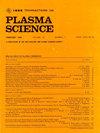Ba(1-x)Sr(x)(Zr0.2Ti0.8)O3陶瓷作为lc基非线性传输线非线性电容的表征
IF 1.5
4区 物理与天体物理
Q3 PHYSICS, FLUIDS & PLASMAS
引用次数: 0
摘要
铁电陶瓷可以用作非线性传输线(NLTLs)中的非线性电容,以产生射频,在国防系统和脉冲雷达中得到应用。它们的主要特征是它们的非线性行为,即电容随温度和电场的变化。其中一个关键的陶瓷材料是钛酸钡(BT)。而陶瓷准电相的纯态则高于居里温度$120~^{\circ}$ C。我们合成并研究了${\mathrm {Ba}}_{(1 -x)}$ ${\mathrm {Sr} _{(x)}$ (Zr0.2Ti0.8)O3陶瓷作为非线性元件,将其准电相变降至接近环境温度的铁电相变,以增强其非线性特性。通过改变频率和外加电场,研究了该材料的电容特性。此外,我们发现该陶瓷复合材料的准电相变发生在浓度为${x} =0.5$ %的锶下。为了说明射频的产生,我们构建并测试了一个非线性LC电路,使用十个含有0.5%锶的陶瓷样品作为非线性电容器。最后,通过推导传播孤立波解的表达式,我们估计产生的射频频率为5.4 MHz,与实验确定的值一致。本文章由计算机程序翻译,如有差异,请以英文原文为准。
Characterization of the Ba(1–x)Sr(x)(Zr0.2Ti0.8)O3 Ceramic as a Nonlinear Capacitor for LC-Based Nonlinear Transmission Lines
Ferroelectric ceramics can be used as nonlinear capacitors in nonlinear transmission lines (NLTLs) to generate radio frequency with applications in defense systems and pulsed radars. Their primary feature is their nonlinear behavior, which is the variation in capacitance with temperature and electric field. One crucial ceramic material for these uses is barium titanate (BT). The ceramic paraelectric phase, however, is above the Curie temperature of $120~^{\circ }$ C in its pure form. We synthesized and studied the ${\mathrm {Ba}}_{(1 -x)}$ ${\mathrm {Sr}}_{(x)}$ (Zr0.2Ti0.8)O3 ceramic as a nonlinear element by downshifting the paraelectric to ferroelectric phase transition close to ambient temperature to enhance the nonlinear characteristics. By varying the frequency and applied electric field, we examined the capacitance behavior of this material. Additionally, we discovered that this ceramic composite’s paraelectric phase transition occurred at a concentration of ${x} =0.5$ % strontium. To illustrate the RF generation, we constructed and tested a nonlinear LC circuit employing ten ceramic samples that contained 0.5% strontium as nonlinear capacitors. Finally, we estimated the RF frequency generated to be 5.4 MHz by deriving expressions for the propagating solitary-wave solution, which agrees with the experimentally determined value.
求助全文
通过发布文献求助,成功后即可免费获取论文全文。
去求助
来源期刊

IEEE Transactions on Plasma Science
物理-物理:流体与等离子体
CiteScore
3.00
自引率
20.00%
发文量
538
审稿时长
3.8 months
期刊介绍:
The scope covers all aspects of the theory and application of plasma science. It includes the following areas: magnetohydrodynamics; thermionics and plasma diodes; basic plasma phenomena; gaseous electronics; microwave/plasma interaction; electron, ion, and plasma sources; space plasmas; intense electron and ion beams; laser-plasma interactions; plasma diagnostics; plasma chemistry and processing; solid-state plasmas; plasma heating; plasma for controlled fusion research; high energy density plasmas; industrial/commercial applications of plasma physics; plasma waves and instabilities; and high power microwave and submillimeter wave generation.
 求助内容:
求助内容: 应助结果提醒方式:
应助结果提醒方式:


